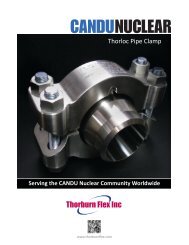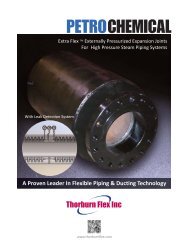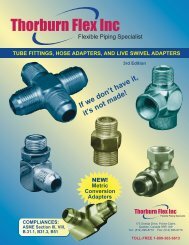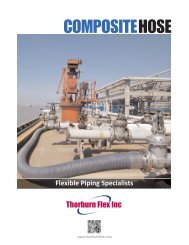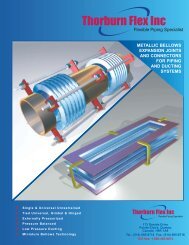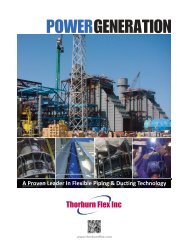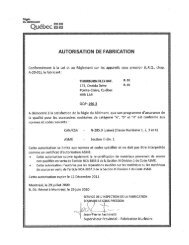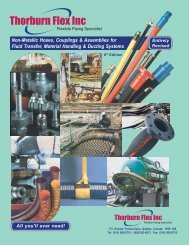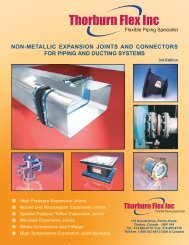Technical Data<strong>Hose</strong> failures normally aren’t a problem– the hose is replaced and the equipment goes back in operation. However, whenthe same problems keep occuring with the same equipment, one must determine their causes and correct them.Improper ApplicationBegin with the most obvious and commoncause of hose failures, improper application,and compare the hose specifications withthe requirements of the application. Payattention especially to the following:1. Maximum operating pressure of thehose.2. Recommended temperature range ofthe hose.3. Whether the hose is rated forvacuum service.4. Fluid compatibility of the hose.Check these against the requirements of theapplication. If they don’t match up, anotherhose must be selected. A <strong>Thorburn</strong> representativecan help you select the proper hose.Analyzing FailuresA physical examination of the failed hose can often offer a clue to the cause of failure. Following are 20 symptomsto look for, along with the conditions causing them:1. Symptom: The hose tube is very hardand has cracked.Analyzing FailuresImproper Assembly and InstallationThe second major cause of premature hosefailures is improper assembly and installationprocedures. This can involve any factorfrom using the wrong hose fitting to poorrouting of the hose.Your <strong>Thorburn</strong> representativecan help you solve this problem.External DamageExternal damage ranges from abrasion andcorrosion to a hose crushed by a forklift truck.Once the cause is identified, most of theseproblems are easily solved. The hose can bere-routed or clamped or a fire sleeve or abrasionguard can be used. With corrosion, thesolution may simply be to switch to a hose witha more corrosion resistant cover or re-routingthe hose away from the corrosive element.3. Symptom: The hose has burst.Examination of the wire reinforcementafter stripping back the cover reveals randombroken wires the entirelength of the hose.Faulty EquipmentA malfunction in equipment is a factor to beconsidered since prompt corrective actioncan avoid serious and costly equipmentbreakdown.Faulty <strong>Hose</strong>Sometimes a failure is caused by the hoseitself. The likeliest cause of a faulty rubberhose is old age. Check the lay line on the hoseto determine the date of manufacture. Thehose may have exceeded its recommendedshelf life. If, after exhausting other possibilities,you suspect the problem is in the manufactureof the hose, contact <strong>Thorburn</strong>. Given effectivequality control methods, the odds of a faultyhose being released for sale are tiny.deteriorated badly.Cause: Heat has a tendency to leach theplasticizers out of the tube. This is amaterial that gives the hose its flexibilityor plasticity. Aerated oil causes oxidationto occur in the tube. This reaction of oxygenand heat will greatly accelerate thehardening of the hose tube. Cavitationoccuring inside the tube would have thesame effect.2. Symptom: The hose is cracked bothexternally and internally but the elastomericmaterials are soft and flexible atroom temperature.Cause: Probably the hose was flexedunder intense cold ambient conditions.Most standard hoses are rated to -40°F(-40°C). Some <strong>Thorburn</strong> hoses are ratedat -55°F (-49°C). Military specified hosesare commonly rated to -65°F (-54°C).Teflon hose is rated to -100°F (-73°C).Some Polyon thermoplastic hoses arerated -65°F (-54°C).Cause: This points to a high frequencypressure impulse condition. SAE impulsetest requirements for a double wire braidreinforcement are 200,000 cycles at 133%of the recommended working pressure.The SAE impulse test requirements for afour spiral wrapped braid reinforcement(100R9) are 300,000 cycles at 133% ofthe recommended working pressure andat 200°F (93°C). If the extrapolated impulsesin a system amount to over a million ina relatively short time a spiral reinforcedhose would be the better choice.4. Symptom: The hose has burst, but thereis no indication of multiple broken wiresthe entire length of the hose. The hosemay have burst in more than oneplace.Cause: The pressure has exceeded minimumstrength of the hose. Either astronger hose is needed or the hydrauliccircuit has a malfunction which is causingunusually high pressure conditions.5. Symptom: The hose has burst. An examinationreveals that the wire braid is rustedand the cover has been cut, abraded or7Cause: The primary function of the cover isto protect the reinforcement. Elements thatmay destroy or remove the hose covers are:1. abrasion2. cutting3. battery acid4. steam cleaners5. chemical cleaning solutions6. muriatic acid (for cement clean-up)7. salt water8. heat9. extreme coldOnce the cover protection is gone, the wirereinforcement is susceptible to attack frommoisture or other corrosive matter.6. Symptom: The hose has burst on the outsidebend and seems elliptical in the bentsection. In the case of the pump supply line,the pump is noisy and very hot. Theexhaust line on the pump is hard and brittle.Cause: In both cases, the likeliest cause isa violation of the minimum bend radius.Check the minimum bend radius and makesure that it is within specifications. In thecase of pump supply line partial collapse ofthe hose is causing the pump to cavitatecreating both noise and heat. This is a mostserious situation and will result in catastrophicpump failure if not corrected.
Technical Data7. Symptom: The hose appears flattened outin two areas and kinked. It has burst in thisarea and also appears twisted.Cause: Torquing of a hydraulic control hosetears loose the reinforcement layers andallows the hose to burst through enlargedgaps between the braided plaits of wirestrands. Use swivel fittings or joints to avoid atwisting force on a hydraulic hose.8. Symptom: The hose tube is broken loosefrom the reinforcement and piled up at theend of the hose. It may protrude from theend of the hose fitting.Cause: Likely cause: high vacuum or wronghose for the vacuum service. No vacuum isrecommended for double wire braid, 4 and 6spiral wire hose unless an internal coil supportis used. This type of failure may happen evento a hose rated for vacuum service, if it iskinked, flattened out or bent too sharply, .9. Symptom: The hose has burst about six toeight inches away from the end fitting. Thewire braid is rusted. There are no cuts orabrasions of the outer cover.Cause: Improper assembly of the hose endfitting allows moisture to enter around theedge of the fitting socket. The moisture willwick through the reinforcement.The heat generatedby the system will drive it out aroundthe fitting area, but six inches away it will betrapped between inner liner and outer cover,causing corrosion of the wire reinforcement.10. Symptom: There are blisters on the coverof the hose. If one pricks the blisters, oil willbe found in them.Cause: A tiny pinhole in the hose tube isallowing high pressure oil to seep betweenit and the cover. Eventually, it will form ablister where the cover adhesion is weakest.For a screw-together reuseable fitting,insufficient lubrication of the hose and fittingcan cause this condition because the drytube will adhere to the rotating nipple andtear enough to allow seepage. Faulty hosecan also cause this condition.11. Symptom: Blistering of the hose coverwhere a gaseous fluid is being used.Cause: High pressure gas effuses throughthe hose tube, gathering under the coverand soon forming a blister where the adhesionis weakest. Specially constructedhoses are available for high pressuregaseous applications. Your <strong>Thorburn</strong> representativecan advise you on the properhose to use in these cases.12. Symptom: Fitting blew off end of hose.Cause: Wrong fitting on the hose. Recheck<strong>Thorburn</strong>’’s specifications and part numbers.For a crimped fitting, the wrong machinesetting can result in over- or undercrimping.The socket of a screw together-fittingfor multiple wire braided hose may be wornbeyond its tolerance.The swaging dies in aswaged hose assembly may be wornbeyond <strong>Thorburn</strong>’s tolerances.The fitting may have been appliedimproperly to the hose. Check <strong>Thorburn</strong>’sinstructions. The hose may have beeninstalled without leaving enough slack tocompensate for the possible 4% shorteningthat may happen when a hose is pressurized,imposing great force on the fitting. Thehose itself may be out of tolerance.13. Symptom: The tube of the hose is badlydeteriorated with evidence of extremeswelling. In some cases, the hose tubemay be “washed out”.Cause: This indicatesthat the hose tube is notcompatible with theagent being carried.Even though the agentis normally compatible,the addition of heat canbe the catalyst that cancause inner liner deterioration. Consult<strong>Thorburn</strong> for a compatibility list. Make sureneither the internal nor the external operatingtemperatures exceed recommendations.14. Symptom: The hose has burst. The hosecover is badly deteriorated and the surfaceof the rubber is crazed.Cause: This could be simply old age. Thecrazed appearance is the effect of weatheringand ozone over a period of time. Tryto determine the age of the hose.<strong>Thorburn</strong> prints or embosses the date onthe outside of the hose.15. Symptom: The hose leaks at the fittingbecause of a crack in the metal tube adjacentto the braze on a split flange head.Cause: Because the crack is adjacent tothe braze, this is a stress failure brought onby a hose that is trying to shorten underpressure, but does’t have sufficient slack todo so.This problem can be cured by lengtheningthe hose assembly or altering therouting to relieve the forces on the fitting.16. Symptom: A spiral reinforced hose hasburst and literally split open with the wireexploded out and badlyentangled.Cause:The hose is too short toaccomodate the changein length occurring while it is pressurized.17. Symptom: The hose hasn’t burst, but isleaking profusely. A bisection of the hosereveals that the tube has been gougedthrough to the wire braid for a distance ofabout two inches.Cause: Indicates erosion of the hose tube.A high velocity needle-like fluid stream beingemitted from an orifice and impinging at asingle point on the hose tube will hydraulicallyremove a section of it. Be sure thehose is not bent close to an orificed port.18. Symptom: The hose is badly flattenedout in the burst area. The tube is veryhard downstream of the burst butappears normal upstream of the burst.Cause: The hose has been kinked either bybending it too sharply or by squashing it soas to create a major restriction. As the velocityof the fluid increases through the restriction,the pressure decreases to the vaporizationpoint of the fluid being conveyed.Often called cavitation, it causes heat andrapid oxidation to occur, hardening the hosetube downstream of the restriction.19. Symptom: The hose fitting has been pulledout of the hose. The hose has been considerablystretched out in length. This may notbe a high pressure application.Cause: Insufficient support of the hose.Very long lengths of hose must be supported,especially if vertical. Otherwise, theweight of the hose along with the weight ofthe fluid in it will be imposed on the hose fitting.This force can be transmitted to a wirerope or chain by clamping the hose to itmuch like the utilities support bundles ofwire from pole to pole. Leave sufficient slackin the hose between clamps to compensatefor possible 4% shortening that can occurwhen the hose is pressurized.20. Symptom: The hose has not burst, but itleaks profusely. A bisection of the hosereveals an inward burst.Cause: Often known as hose tube blowdown,this type of failure is usually associatedwith very low viscosity fluids such as air,nitrogen, freon, and other gases. Under highpressure conditions, the gases effuse intothe pores of the hose tube charging them uplike miniature accumulators. If the pressure issuddenly reduced to zero, the entrappedgases literally explode out of the tube, oftentearing holes in it. In some hose constructions,a second hose tube made from a plasticsuch as nylon, is inserted into the hose.A small leak allows the gaseous fluid toseep between the two inner liners andwhen the pressure is reduced to zero, theinnermost liner will collapse because of thetrapped pressure around its outer diameter.8




